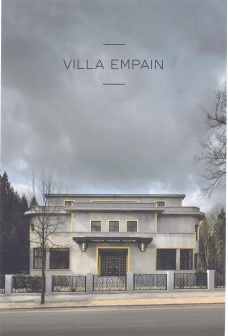Villa Empain
Villa Empain
Diane Hennebert, Anne-Sophie Augustyniak and Christine Rouffin (Orgs.)
Ministry of the Brussels, Brussels; 1st edition, 2010
edition: english
paperback
192 p
21 x 30 x 1,5 cm
1000 g
illustrated
fullcolor
photos
ISBN
978-2-930457-50-5
(, )

about the book
With the Stoclet Palace, built by the Austrian architect Josef Hoffman in 1911, the Villa Empain is certainly one of the most beautiful architectural masterpieces of Art Deco in Brussels. In 1930, at the age of 21, Baron Louis Empain had this private mansion of 2500 square meters built, on the prestigious avenue of the Nation which was later on renamed as Franklin Roosevelt Avenue. It is to the Swiss architect Michel Polak, with the collaboration of Alfred Hoch that this splendid mansion is entrusted to. Michel Polak is already well known in Belgium: one of his major works consisted of the famous "Residence Palace " (1928) and the dental institute George Eastman in the Leopold Parc.
The project conceived for Baron Empain on a property of 55 acres includes a monumental villa with four granite polished facades, a garden surrounding a decorated swimming pool of pergola and a caretaker's lodge. The modern and luxurious character of this construction generated enthusiasm and curiosity. It is true that the diversity and the quality of the materials used (marble, polished granite, bronzes, wrought iron, glasses and precious woods), the refinement of the details and the coherence of the whole imposing simple lines has contributed from the start to its patrimonial value.
Great Art lover, Louis Empain donated the property to the Belgian State in 1937, with the intention of creating a museum of decorative and contemporary art. Unfortunately this project was not carried out till after few years under the direction of La Cambre School of Arts. In 1943, the German army requisitioned the villa and occupied it until the end of the war. Thereafter it sheltered the allied armies and as well as the embassy of the USSR and did not fulfill the functions for which it was offered to the Belgian State. Considering that the latter had not honored its engagement, Louis Empain recovered his property in the beginning of the sixties before reselling it in 1973. For nearly ten years it was rented to the TV channel RTL.
Since the beginning of the years 1990, the building remained practically unoccupied and left in a state of minimal maintenance. Fortunately, its recent acquisition by the Boghossian Foundation makes it possible to consider its future in an optimistic way. Its approved classification by the Government of Brussels-Capital Region in March 2007 and its future assignment into a center of dialogue between the cultures of the East and the West guarantees indeed the revival of this splendid house.
about the author
Diane Hennebert
Lecturer in philosophy and with a degree in journalism, Free University of Brussels. Taught history of architecture and design at the École supérieure des Arts plastiques et visuels in Mons. Is coordinating the restauration of Villa Empaim.
Anne-Sophie Augustyniak
With a degree awarded by the artworks restoration workshop at the École supérieure dês Arts visuels de La Cambre and specialising in the field of polychorme wood carving, she has participated in the restoration of many works in Belgium.
Christine Rouffin


